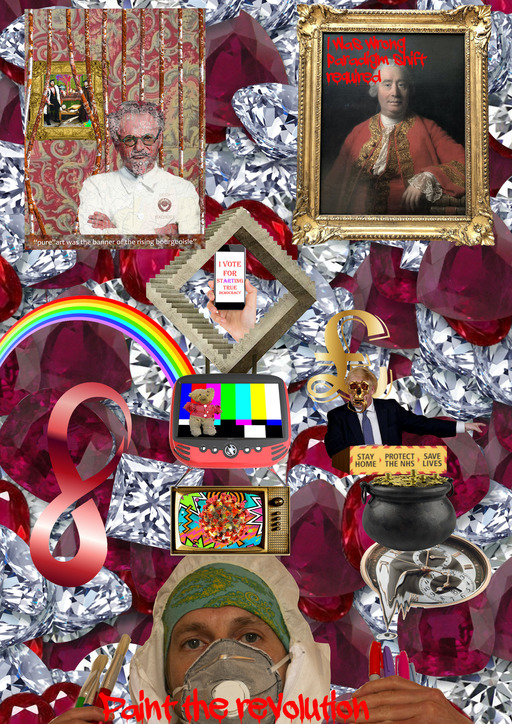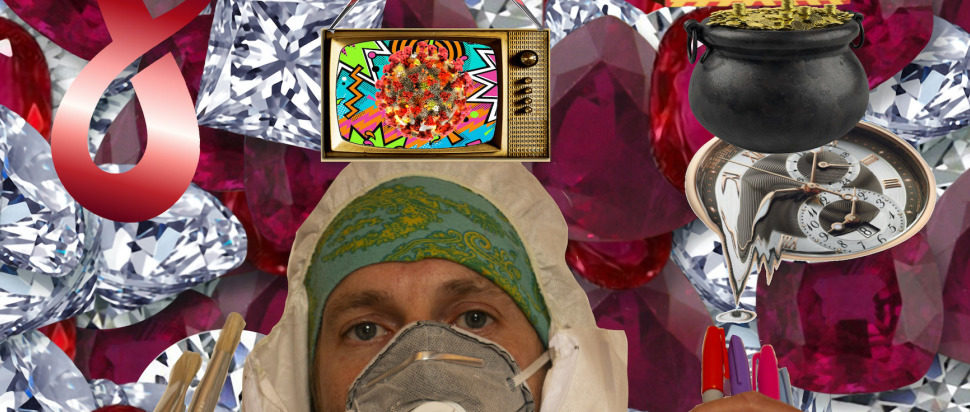How Open is the Door?: Arts accessibility in Scotland
As COVID-19 threatens to increase the diversity deficit in the arts, it’s more important than ever to create an inclusive arts sector in the UK
Arts councils, Creative Scotland and even the government (both Scottish and UK) praise diversity, but in practice struggle to accommodate the many societal barriers facing the disabled and/or chronically ill. The future may be accessible, but will it be equitable?
Alex Callaghan is an artist, activist and researcher currently studying an MA in Arts, Cultural and Festival Management at Queen Margaret University. Inspired by disability-led movements, he is focusing his dissertation on a non-hierarchical, participatory research project. He conducted an online survey and facilitated disabled-led focus groups in order to co-design disability policy recommendations for Creative Scotland’s consideration.
Collective projects like Not Going Back to Normal (NGBTN) have laid the groundwork for Callaghan’s research, especially Nelly Dean’s three key demands in their Manifesto. In the opening essay, The Impossible World, artists and curators Harry Josephine Giles and Sasha Callaghan propose a radical future without normality. They say representation of disabled people in Scotland is “woefully small” – that the challenge is no longer identifying barriers, but “winning the resources to change them”.
In Manifesto, Dean writes about the history of the Disability Discrimination Act (now known as the Equality Act). Before 1995 it was legal to discriminate against disabled people in the UK. Tired of everyday occurrences of discrimination, disabled and deaf artists led the campaign with direct action. That’s why Dean’s question is so urgent: “Why are we still having to fight the same ignorant discrimination and lack of voice in the arts nearly 30 years on?”
It’s all about the money
As inclusivity and diversity have become buzzwords, conversations around access start and end with money. Even with more festivals going entirely online, recent research shows that although online delivery may initially increase access, it has the potential to create more barriers for people with protected identities in the long term.
Callaghan’s research shows that without policy change, diversity will not increase and may in fact lessen. He says: “Accessibility is one key part of the picture. Another is actually making things more inclusive for disabled people to produce art.” He goes on to say that “funding bodies may listen and talk about the barriers, but if you’ve got a lack of people with lived experience working internally then it's hard to get a grasp on things, [and] how to actually change them.”
Stigma, coupled with a lack of clear policies put in place for disabled artists, makes it incredibly hard to find inclusive opportunities. In Scotland, fewer than 5% of the permanent and freelance staff in visual arts Regularly Funded Organisations (RFOs) have identified issues related to gender, ethnicity and disability. Survey findings from the 2021 #WeShallNotBeRemoved campaign reveal the shocking insecurity facing disabled and BAME artists, with one third describing themselves as precariously employed or on a zero-hours contract, a further third having experienced homelessness, and nearly two-thirds worried that they will have to leave the creative industries. While diversifying the arts has become a marketable catchphrase for institutions, no arts councils have formally responded to the findings from the survey.
According to Creative Scotland’s EDI (Equality, Diversity and Inclusion) policy, the door is open for disabled and deaf artists, but Callaghan asks, “How open is the door? On what grounds do you get through the door?” Financial recovery plans have been criticised for prioritising organisations rather than workers, and that project-based business models further alienate workers with protected characteristics. Even with the protection of the Equality Act, there is limited financial support for the many different types of experiences disabled artists face. Helen Fox, a writer, actor, and active participant in the focus groups, says: “we are not a small group of people but are often divided into our separate disability groups and so suppressed as minority groups that there is no financial assistance or support for.”
Scottish scholar Ruth Eikhof argues that workers from ‘at risk’ groups are more likely to experience discrimination because of COVID-19. “Workers who require additional safety measures, for instance, extra space, physically separated workspaces or extra cleaning, as well as more in-depth, individual consultations… make them ‘costlier’ human resources.”

Pre-COVID research also shows that employers’ lack of knowledge about disability made them less likely to even consider hiring a disabled person, even if no reasonable adjustments were required. It is likely that the lack of clarity about ‘at risk’ workers post-COVID will make employers ‘play safe’ and favour workers without potential ‘at risk’ characteristics. Such practices would particularly negatively impact BAME and disabled workers, for whom infection and mortality rates have been reported to be significantly higher.
Quotas for change
In order to make the arts sector more inclusive we need more than progressive policy changes, but industry-wide change. Eikhof writes about three drivers of unequal workplace participation and advancement in the cultural economy: first, a Eurocentric, white, middle class, non-disabled and male idea of talent; second, the persistence of misogynist and discriminatory working cultures; third, the typical business models and their resultant exclusionary work and employment practices. A social model of disability (whereby people are disabled by societal barriers rather than by their impairment or difference) means that policy and industry-wide change needs to be able to name and dismantle these unjust drivers. It’s complex, but not impossible.
Collectivising works, and Callaghan and Fox have felt energised by the passion for change from the focus group participants. “It’s become evident [that] Creative Scotland is a key part of the picture," says Callaghan, "but I also think that the Scottish government is a key part. I think that a way for influencing change where disabled artists are supported far better is trying to link the two up. Perhaps there's room to argue that the Scottish government should actually be providing Creative Scotland with the resources to ensure that they can better support disabled people.”
For the focus group, policy recommendations are just the start. Callaghan says: “I feel that opening up the conversation by asking questions that aren’t regularly being asked is a promising starting point to working towards something that can actually reduce these barriers.” People are committed to creating a genuinely diverse creative sector. “There is a real appetite to see progressive change in the arts," they add, "with a key emphasis on ensuring that disabled people can maintain and build careers.” There’s a lot to be optimistic about.
Callaghan admits that it remains tricky to make universal policy change, but that change is still important: “Some things have changed, but the root causes of things like discrimination are firmly embedded in so many institutions.” Fox asks, meanwhile, “Does our voice matter? Nothing changes if we are not prepared to speak up and say something.”
It’s all about the art
Disabled-led groups like #NGBTN and #WWNBR have amplified disabled voices in Scotland, reaching a global audience. While there is a passion for change, there is a real concern that Disability arts is a silo, often leaving disabled artists without the means to integrate into mainstream projects. Fox expresses her frustration: “Disabled people shouldn't be seen as 'other'. The idea of a 'disabled' festival is really off-putting to me. It feels like we'd be corralled into a space, given funding so the mainstream wouldn't have to 'deal' with us… I have thus far avoided writing a play specifically about disability because it feels 'otherish'. I want to, but I fear it.
"Disabled people should be 'visibly' (and I don't mean only visibly disabled) on TV, in film, on stage, in galleries, as well as all the unseen and essential roles in the arts. It should be 'normal' to see several disabled people in productions without it being about disability. Nearly a quarter of all people are disabled. Where do you see this quarter of people represented?”
In the last paragraph of Dean’s Manifesto, they write: “Art organisations treat Disabled and Deaf Artists differently – they don’t see our work as quality, they don’t understand the politicalness of it. They judge it as inferior. That needs to change.” This sentiment was shared throughout the 33 responses to Callaghan’s online survey.
Many respondents were unaware that there is even public funding available, which according to Callaghan suggests a need for greater outreach. He elaborates: “There was quite an overriding impression from the survey responses that Creative Scotland don't offer enough support for things like filling out applications, but some people weren’t even aware that they have a service to support people with their applications, which is open to non-disabled people as well. Again, if people aren’t aware of this maybe it suggests that Creative Scotland should be doing more to showcase that there is enough support for people who need it.”
Creative Scotland are setting up their own EDI communities, but there is scepticism as to whether these groups have any teeth to make change. Callaghan worries that a lack of autonomy could result in more gatekeeping and cherry-picking of policies that are easier to implement. “I think widening diversity right now is almost becoming a marketing brand in itself," he says, "where certain protected characteristics will be in fashion for a couple of years and then there will be a move, and then it goes around the wheel again... There’s a lot of performativity within government agencies, but then it comes back to why I am really convinced that having a national Disability Arts body that has agency and autonomy, that does receive regular funding, could be a way to ensure that things don’t just get talked about and then sidelined.”
As Dean writes: “Look around – there are some great people out there who are Disabled, Deaf, are BAME, LGBTQI+, have Learning Disabilities, Refugees, Asylum Seekers and Migrants. There is rich talent that is being ignored... until our creative voices are filling submissions for funding. When it becomes competitive then funders have done their work right.” If we truly want equality in the arts sector we have to create it. Building collective agency works. Even if it starts small.
Earlier this year Alchemy Film & Arts, LUX Scotland and The Skinny worked together to offer an open-call programme of writing workshops for early-career writers, addressing artists' moving image and experimental film
This text is the third in a new series of commissioned writing that resulted from this partnership programme
Inline image: What’s on My Mind (2020) by Alex Callaghan
